2022 HYUNDAI ELANTRA HYBRID oil level
[x] Cancel search: oil levelPage 99 of 529
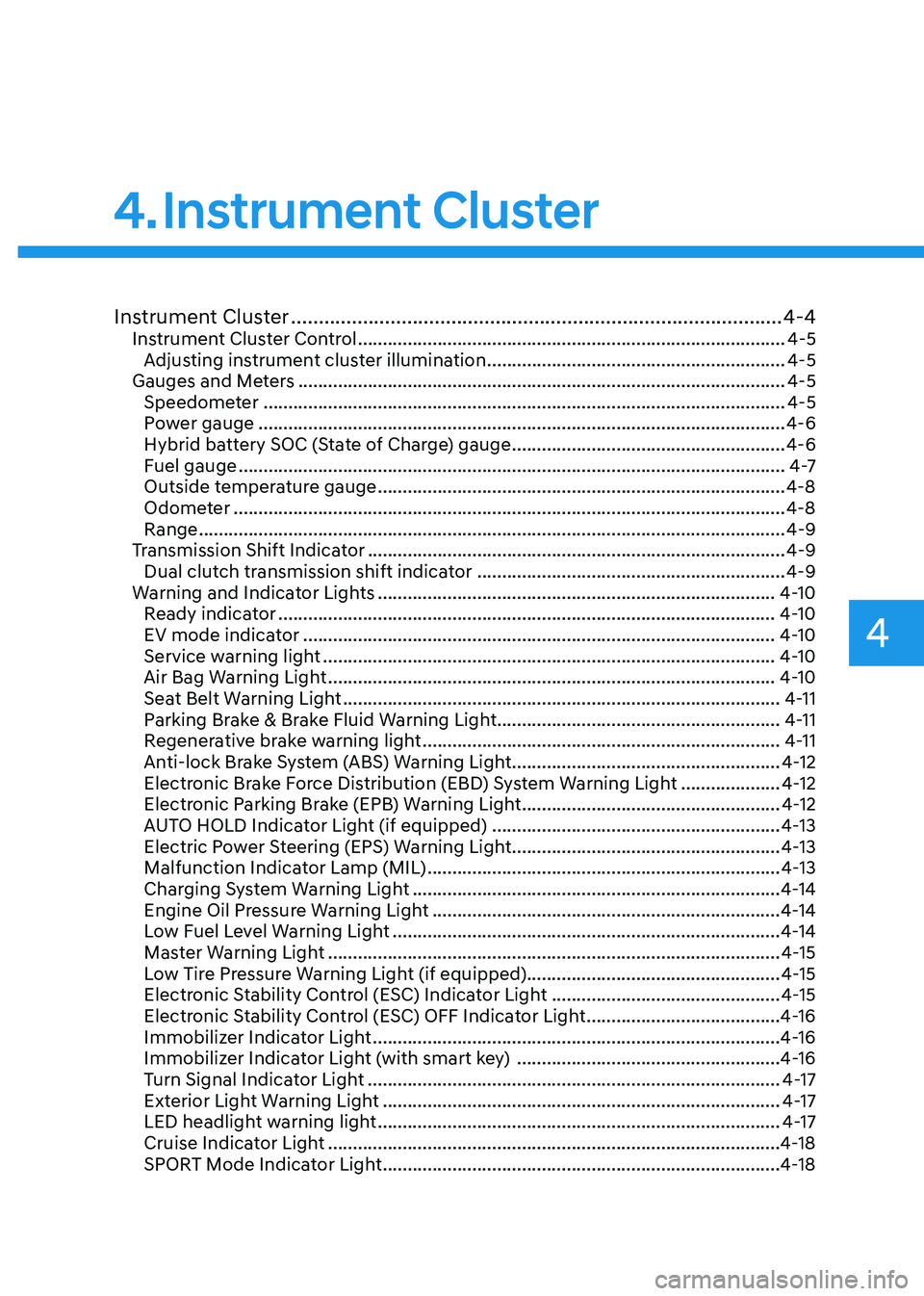
4
Instrument Cluster ......................................................................................... 4-4
Instrument Cluster Control ...................................................................................... 4-5
Adjusting instrument cluster illumination ............................................................4-5
Gauges and Meters .................................................................................................. 4-5
Speedometer ......................................................................................................... 4-5
Power gauge .......................................................................................................... 4-6
Hybrid battery SOC (State of Charge) gauge .......................................................4-6
Fuel gauge .............................................................................................................. 4 -7
Outside temperature gauge .................................................................................. 4-8
Odometer ............................................................................................................... 4-8
Range ...................................................................................................................... 4-9
Transmission Shift Indicator .................................................................................... 4-9
Dual clutch transmission shift indicator ..............................................................4-9
Warning and Indicator Lights ................................................................................ 4-10
Ready indicator .................................................................................................... 4-10
EV mode indicator ............................................................................................... 4-10
Service warning light ........................................................................................... 4-10
Air Bag Warning Light .......................................................................................... 4-10
Seat Belt Warning Light ........................................................................................ 4-11
Parking Brake & Brake Fluid Warning Light .........................................................4-11
Regenerative brake warning light ........................................................................ 4-11
Anti-lock Brake System (ABS) Warning Light ......................................................4-12
Electronic Brake Force Distribution (EBD) System Warning Light ....................4-12
Electronic Parking Brake (EPB) Warning Light ....................................................4-12
AUTO HOLD Indicator Light (if equipped) ..........................................................4-13
Electric Power Steering (EPS) Warning Light ......................................................4-13
Malfunction Indicator Lamp (MIL) ....................................................................... 4-13
Charging System Warning Light .......................................................................... 4-14
Engine Oil Pressure Warning Light ...................................................................... 4-14
Low Fuel Level Warning Light .............................................................................. 4-14
Master Warning Light ........................................................................................... 4-15
Low Tire Pressure Warning Light (if equipped)................................................... 4-15
Electronic Stability Control (ESC) Indicator Light ..............................................4-15
Electronic Stability Control (ESC) OFF Indicator Light .......................................4-16
Immobilizer Indicator Light .................................................................................. 4-16
Immobilizer Indicator Light (with smart key) .....................................................4-16
Turn Signal Indicator Light ................................................................................... 4-17
Exterior Light Warning Light ................................................................................ 4-17
LED headlight warning light ................................................................................. 4-17
Cruise Indicator Light ........................................................................................... 4-18
SPORT Mode Indicator Light ................................................................................ 4-18
4. Instrument Cluster
Page 112 of 529
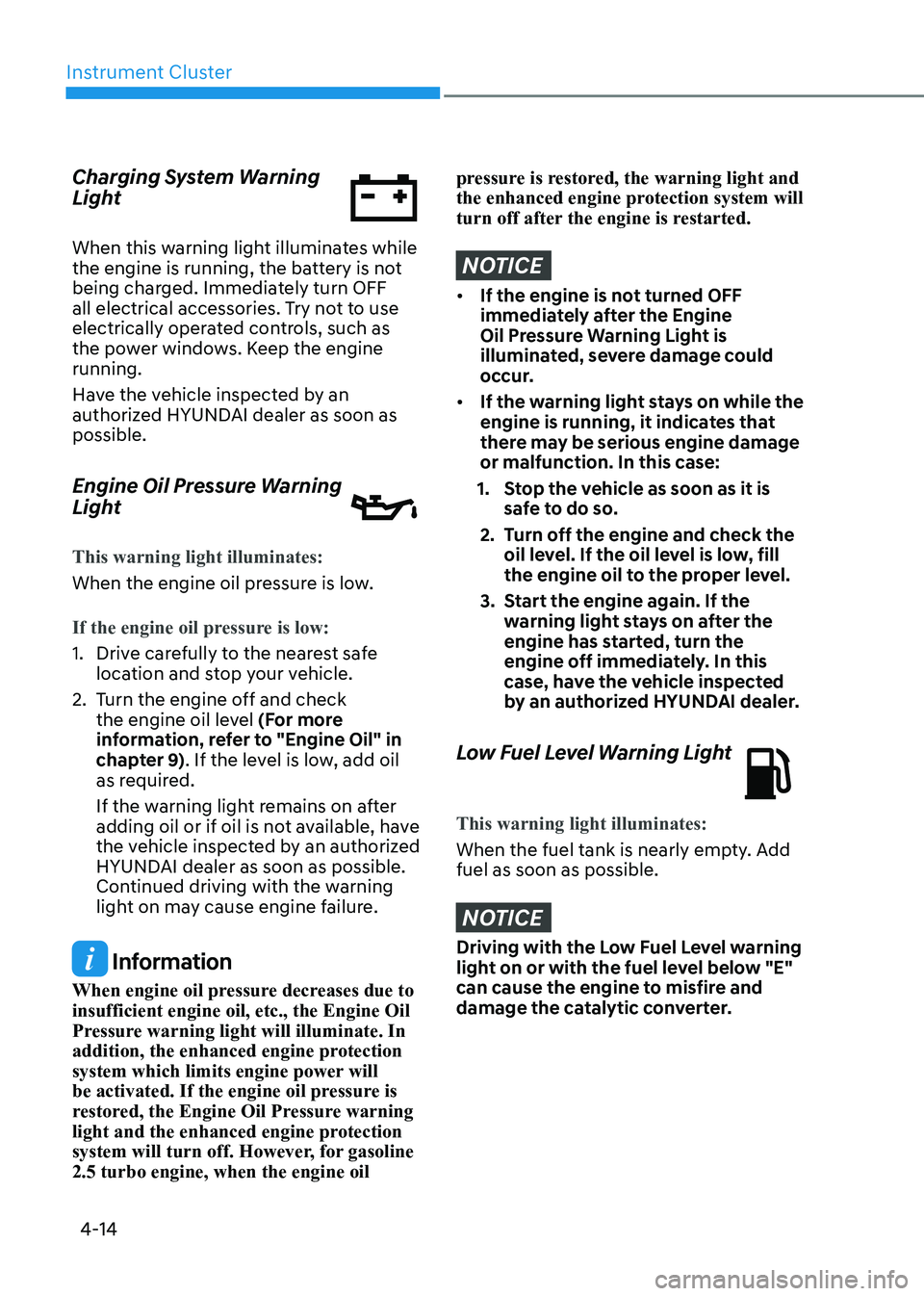
Instrument Cluster
4-14
Charging System Warning
Light
When this warning light illuminates while
the engine is running, the battery is not
being charged. Immediately turn OFF
all electrical accessories. Try not to use
electrically operated controls, such as
the power windows. Keep the engine running.
Have the vehicle inspected by an
authorized HYUNDAI dealer as soon as possible.
Engine Oil Pressure Warning
Light
This warning light illuminates:
When the engine oil pressure is low.
If the engine oil pressure is low:
1. Drive carefully to the nearest safe
location and stop your vehicle.
2. Turn the engine off and check the engine oil level (For more
information, refer to "Engine Oil" in
chapter 9) . If the level is low, add oil
as required.
If the warning light remains on after
adding oil or if oil is not available, have
the vehicle inspected by an authorized
HYUNDAI dealer as soon as possible.
Continued driving with the warning
light on may cause engine failure.
Information
When engine oil pressure decreases due to insufficient engine oil, etc., the Engine Oil
Pressure warning light will illuminate. In
addition, the enhanced engine protection
system which limits engine power will
be activated. If the engine oil pressure is
restored, the Engine Oil Pressure warning
light and the enhanced engine protection
system will turn off. However, for gasoline 2.5 turbo engine, when the engine oil
pressure is restored, the warning light and
the enhanced engine protection system will
turn off after the engine is restarted.
NOTICE
• If the engine is not turned OFF
immediately after the Engine
Oil Pressure Warning Light is
illuminated, severe damage could
occur.
• If the warning light stays on while the
engine is running, it indicates that
there may be serious engine damage or malfunction. In this case:
1. Stop the vehicle as soon as it is safe to do so.
2. Turn off the engine and check the oil level. If the oil level is low, fill
the engine oil to the proper level.
3. Start the engine again. If the warning light stays on after the
engine has started, turn the
engine off immediately. In this
case, have the vehicle inspected
by an authorized HYUNDAI dealer.
Low Fuel Level Warning Light
This warning light illuminates:
When the fuel tank is nearly empty. Add fuel as soon as possible.
NOTICE
Driving with the Low Fuel Level warning
light on or with the fuel level below "E"
can cause the engine to misfire and
damage the catalytic converter.
Page 224 of 529
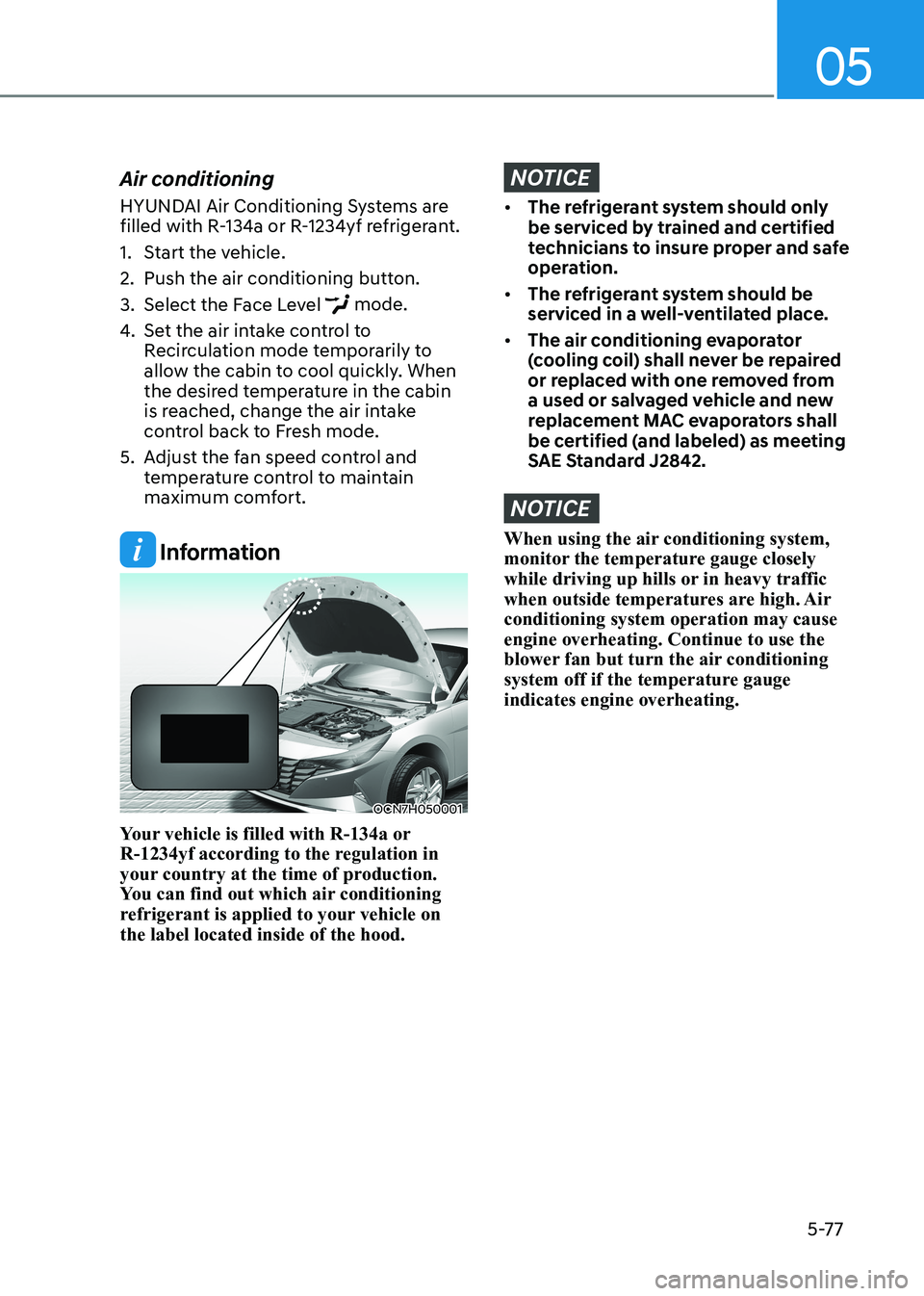
05
5-77
Air conditioning
HYUNDAI Air Conditioning Systems are
filled with R-134a or R-1234yf refrigerant.
1. Start the vehicle.
2. Push the air conditioning button.
3. Select the Face Level
mode.
4. Set the air intake control to
Recirculation mode temporarily to
allow the cabin to cool quickly. When
the desired temperature in the cabin
is reached, change the air intake
control back to Fresh mode.
5. Adjust the fan speed control and temperature control to maintain
maximum comfort.
Information
OCN7H050001
Your vehicle is filled with R-134a or
R-1234yf according to the regulation in
your country at the time of production.
You can find out which air conditioning
refrigerant is applied to your vehicle on the label located inside of the hood.
NOTICE
• The refrigerant system should only
be serviced by trained and certified
technicians to insure proper and safe
operation.
• The refrigerant system should be
serviced in a well-ventilated place.
• The air conditioning evaporator
(cooling coil) shall never be repaired
or replaced with one removed from
a used or salvaged vehicle and new
replacement MAC evaporators shall
be certified (and labeled) as meeting
SAE Standard J2842.
NOTICE
When using the air conditioning system,
monitor the temperature gauge closely
while driving up hills or in heavy traffic
when outside temperatures are high. Air conditioning system operation may cause engine overheating. Continue to use the
blower fan but turn the air conditioning
system off if the temperature gauge indicates engine overheating.
Page 285 of 529
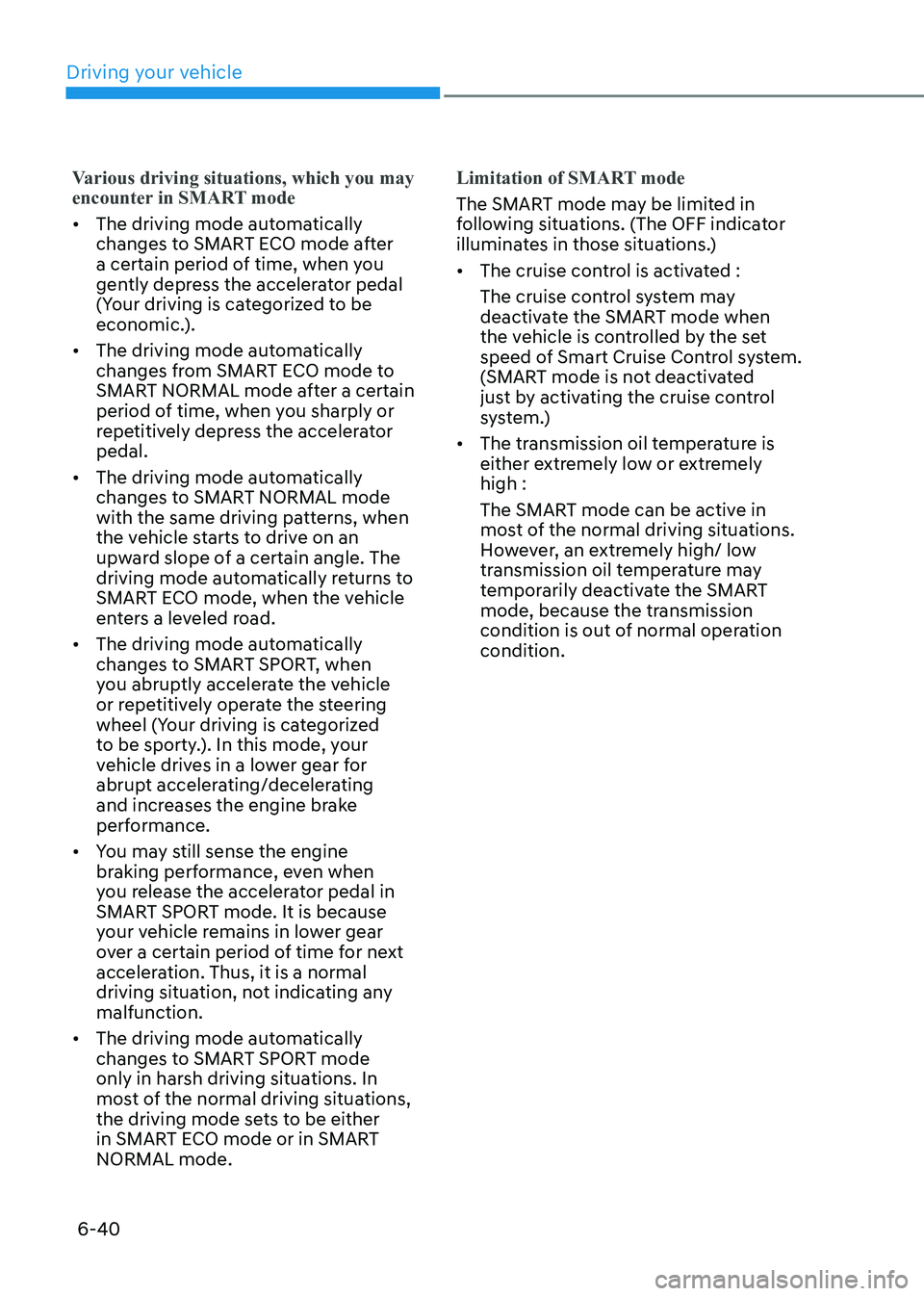
Driving your vehicle
6-40
Various driving situations, which you may
encounter in SMART mode
• The driving mode automatically
changes to SMART ECO mode after
a certain period of time, when you
gently depress the accelerator pedal
(Your driving is categorized to be
economic.).
• The driving mode automatically
changes from SMART ECO mode to
SMART NORMAL mode after a certain
period of time, when you sharply or
repetitively depress the accelerator pedal.
• The driving mode automatically
changes to SMART NORMAL mode
with the same driving patterns, when
the vehicle starts to drive on an
upward slope of a certain angle. The
driving mode automatically returns to
SMART ECO mode, when the vehicle
enters a leveled road.
• The driving mode automatically
changes to SMART SPORT, when
you abruptly accelerate the vehicle
or repetitively operate the steering
wheel (Your driving is categorized
to be sporty.). In this mode, your
vehicle drives in a lower gear for
abrupt accelerating/decelerating
and increases the engine brake
performance.
• You may still sense the engine
braking performance, even when
you release the accelerator pedal in
SMART SPORT mode. It is because
your vehicle remains in lower gear
over a certain period of time for next
acceleration. Thus, it is a normal
driving situation, not indicating any malfunction.
• The driving mode automatically
changes to SMART SPORT mode
only in harsh driving situations. In
most of the normal driving situations,
the driving mode sets to be either
in SMART ECO mode or in SMART NORMAL mode.
Limitation of SMART mode
The SMART mode may be limited in
following situations. (The OFF indicator
illuminates in those situations.) • The cruise control is activated :
The cruise control system may
deactivate the SMART mode when
the vehicle is controlled by the set
speed of Smart Cruise Control system.
(SMART mode is not deactivated
just by activating the cruise control
system.)
• The transmission oil temperature is
either extremely low or extremely high :
The SMART mode can be active in
most of the normal driving situations.
However, an extremely high/ low
transmission oil temperature may
temporarily deactivate the SMART
mode, because the transmission
condition is out of normal operation condition.
Page 289 of 529
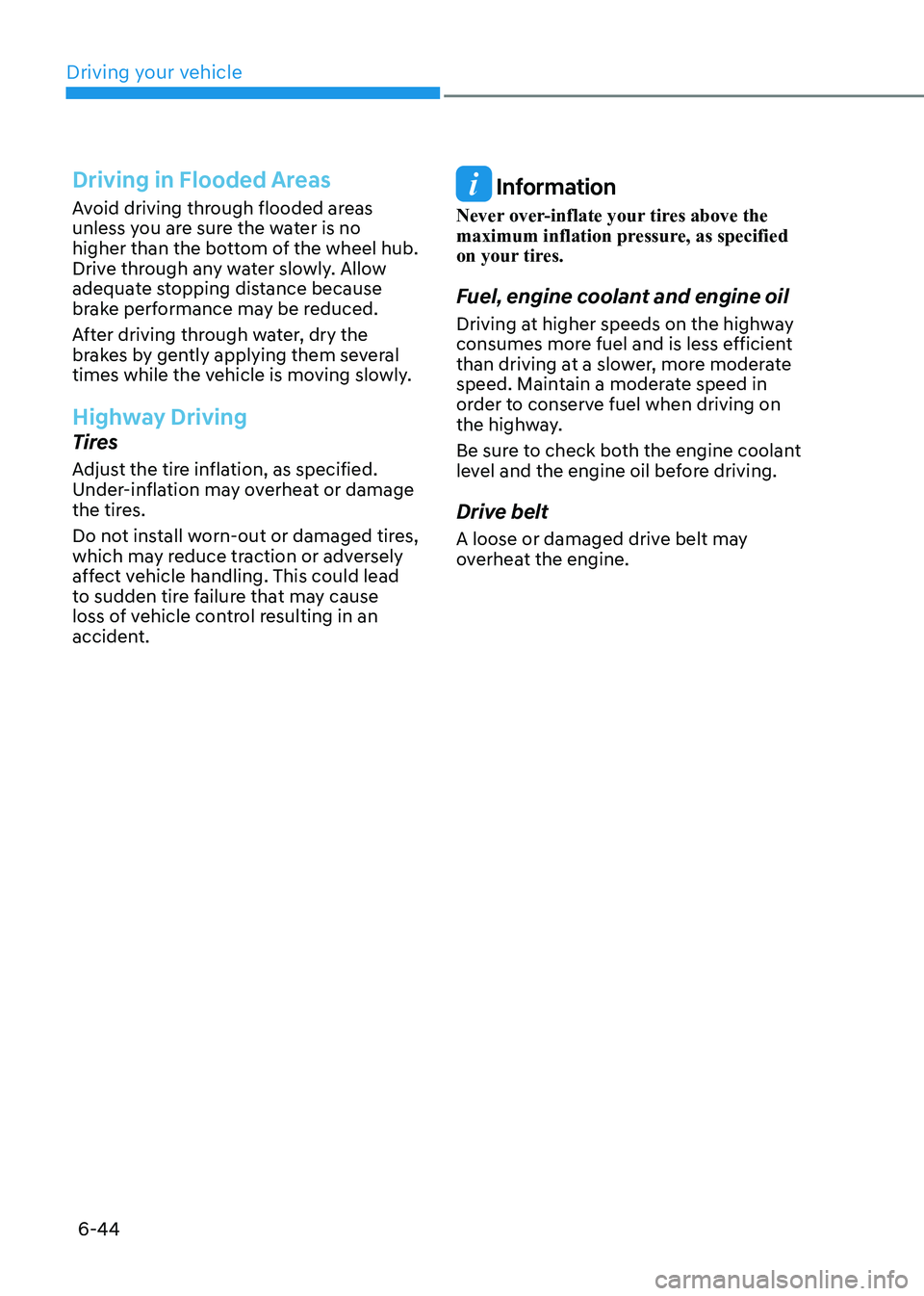
Driving your vehicle
6-44
Driving in Flooded Areas
Avoid driving through flooded areas
unless you are sure the water is no
higher than the bottom of the wheel hub.
Drive through any water slowly. Allow
adequate stopping distance because
brake performance may be reduced.
After driving through water, dry the
brakes by gently applying them several
times while the vehicle is moving slowly.
Highway Driving
Tires
Adjust the tire inflation, as specified.
Under-inflation may overheat or damage
the tires.
Do not install worn-out or damaged tires,
which may reduce traction or adversely
affect vehicle handling. This could lead
to sudden tire failure that may cause
loss of vehicle control resulting in an
accident.
Information
Never over-inflate your tires above the
maximum inflation pressure, as specified
on your tires.
Fuel, engine coolant and engine oil
Driving at higher speeds on the highway
consumes more fuel and is less efficient
than driving at a slower, more moderate
speed. Maintain a moderate speed in
order to conserve fuel when driving on
the highway.
Be sure to check both the engine coolant
level and the engine oil before driving.
Drive belt
A loose or damaged drive belt may
overheat the engine.
Page 291 of 529

Driving your vehicle
6-46
Winter Precautions
Use high quality ethylene glycol
coolant
Your vehicle is delivered with high
quality ethylene glycol coolant in the
cooling system. It is the only type of
coolant that should be used because it
helps prevent corrosion in the cooling
system, lubricates the water pump and
prevents freezing. Be sure to replace or
replenish your coolant in accordance
with the maintenance schedule in
chapter 8. Before winter, have your
coolant tested to assure that its freezing
point is sufficient for the temperatures
anticipated during the winter.
Change to "winter weight" oil if necessary
In some climates it is recommended that
a lower viscosity "winter weight" oil be
used during cold weather. See chapter 8
for recommendations. If you aren't sure
what weight oil you should use, consult
an authorized HYUNDAI dealer.
Check battery and cables
Winter puts additional burdens on the
battery system. Visually inspect the
battery and cables as described in
chapter 8. The level of charge in your
battery can be checked by an authorized
HYUNDAI dealer or a service station.Check spark plugs and ignition
system
Inspect your spark plugs as described in
chapter 8 and replace them if necessary. Also check all ignition wiring and
components to be sure they are not
cracked, worn or damaged in any way.
Use approved window washer anti-
freeze in system
To keep the water in the window washer
system from freezing, add an approved
window washer anti-freeze solution in
accordance with instructions on the
container. Window washer anti-freeze is
available from an authorized HYUNDAI
dealer and most auto parts outlets. Do
not use engine coolant or other types
of antifreeze as these may damage the
paint finish.
Do not let your parking brake freeze
Under some conditions your parking
brake can freeze in the engaged position.
This is most likely to happen when
there is an accumulation of snow or
ice around or near the rear brakes or
if the brakes are wet. If there is a risk
the parking brake may freeze, apply
it only temporarily while you put the
gear selector lever in P and block the
rear wheels so the car cannot roll. Then
release the parking brake.
Page 448 of 529
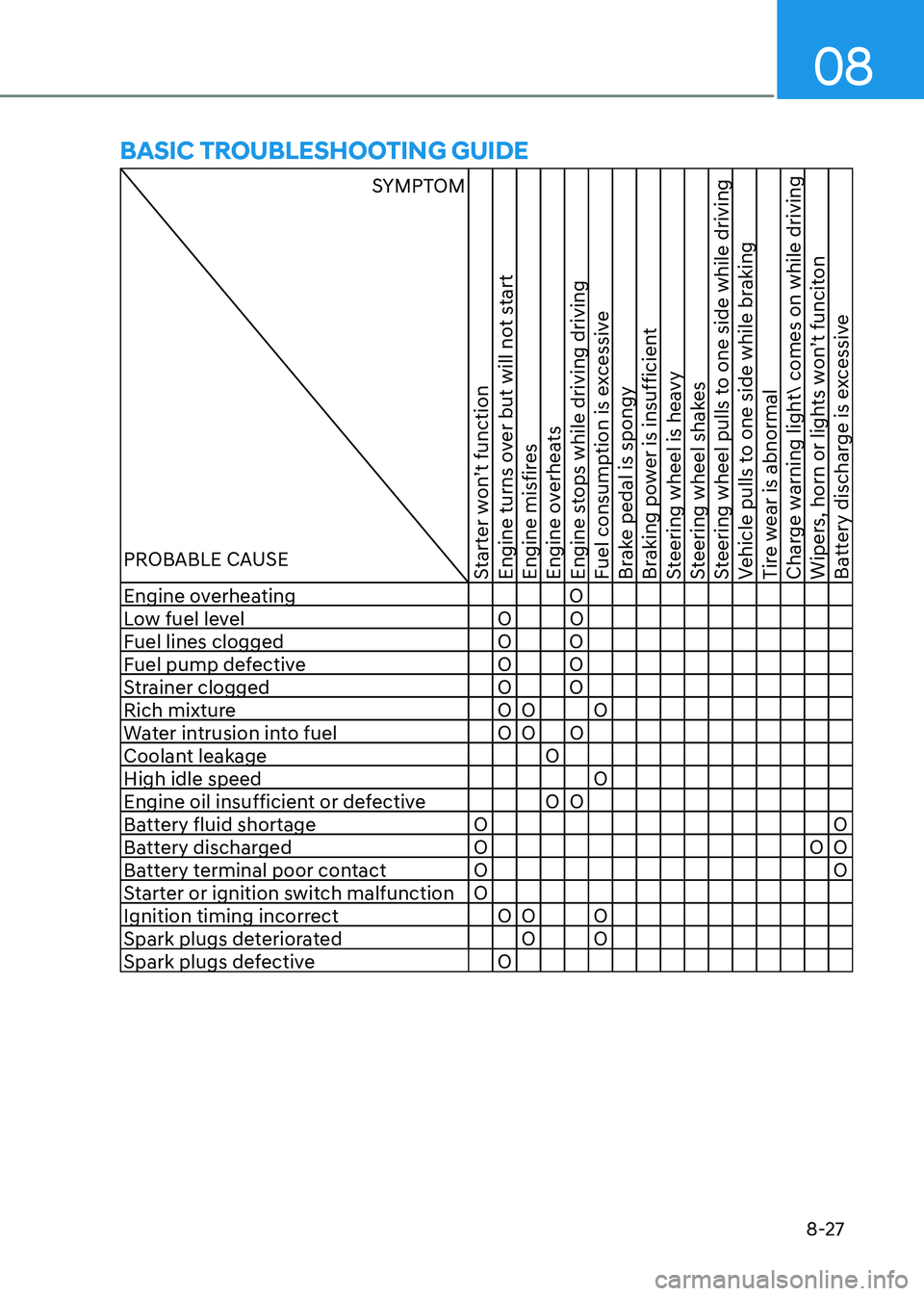
08
8-27
BasiC troUBlesHooting gUide
SYMPTOM
PROBABLE CAUSE
Starter won’t function
Engine turns over but will not start
Engine misfires
Engine overheats
Engine stops while driving driving
Fuel consumption is excessive
Brake pedal is spongy
Braking power is insufficient
Steering wheel is heavy
Steering wheel shakes
Steering wheel pulls to one side while driving
Vehicle pulls to one side while braking
Tire wear is abnormal
Charge warning light comes on while driving
Wipers, horn or lights won’t funciton
Battery discharge is excessive
Engine overheating O
Low fuel level O O
Fuel lines clogged O O
Fuel pump defective O O
Strainer clogged O O
Rich mixture O O O Water intrusion into fuel O O O
Coolant leakage OHigh idle speed O
Engine oil insufficient or defective O O
Battery fluid shortage O O
Battery discharged O O O
Battery terminal poor contact O O
Starter or ignition switch malfunction O
Ignition timing incorrect O O O Spark plugs deteriorated O O Spark plugs defective O
Page 450 of 529
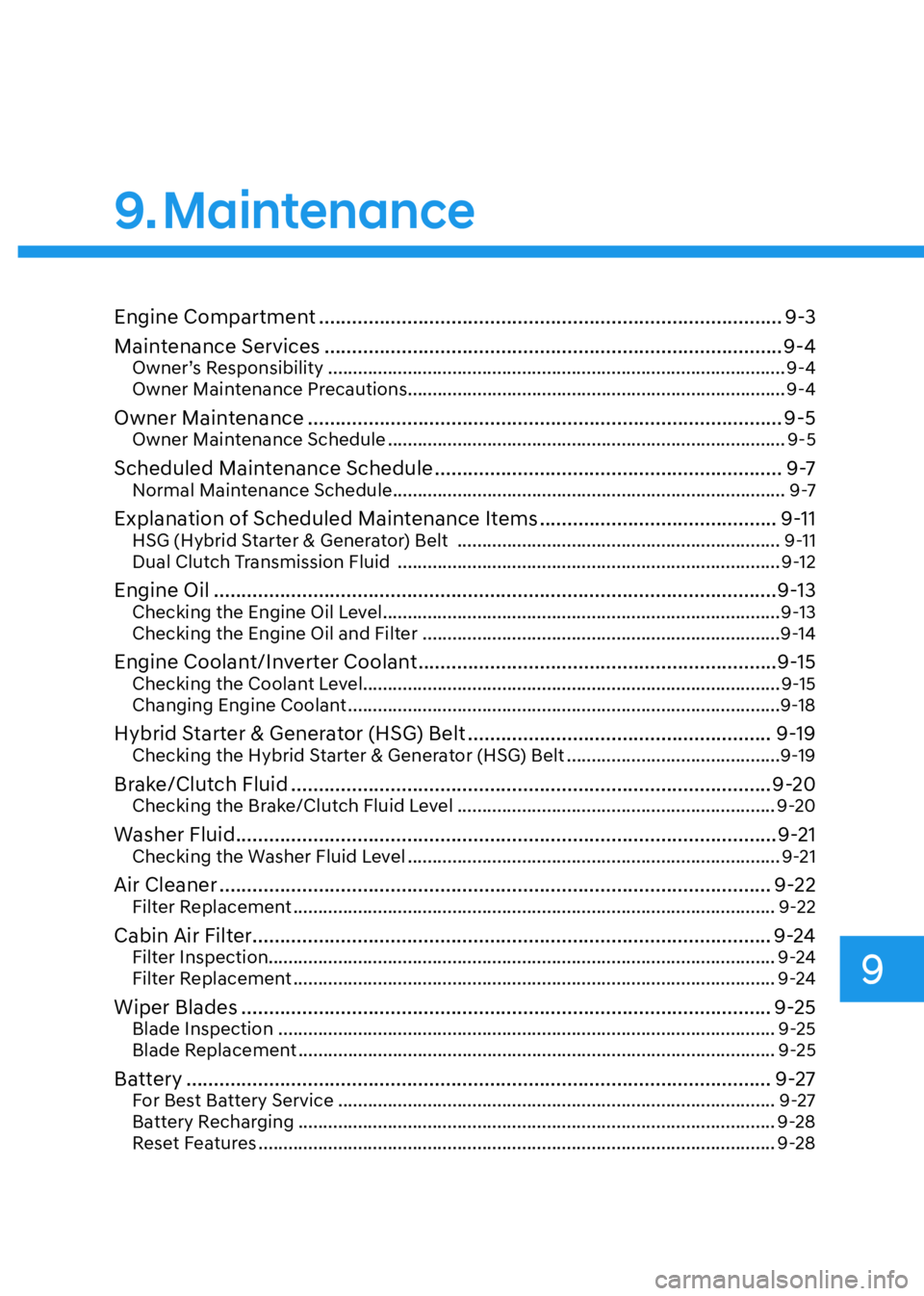
Engine Compartment .................................................................................... 9-3
Maintenance Services ...................................................................................9-4Owner’s Responsibility ............................................................................................ 9-4
Owner Maintenance Precautions ............................................................................ 9-4
Owner Maintenance ...................................................................................... 9-5 Owner Maintenance Schedule ................................................................................ 9-5
Scheduled Maintenance Schedule ............................................................... 9-7 Normal Maintenance Schedule ............................................................................... 9-7
Explanation of Scheduled Maintenance Items ........................................... 9-11 HSG (Hybrid Starter & Generator) Belt ................................................................. 9-11
Dual Clutch Transmission Fluid ............................................................................. 9-12
Engine Oil ......................................................................................................9-13 Checking the Engine Oil Level ................................................................................9-13
Checking the Engine Oil and Filter ........................................................................9-14
Engine Coolant/Inverter Coolant .................................................................9-15 Checking the Coolant Level.................................................................................... 9-15
Changing Engine Coolant .......................................................................................9-18
Hybrid Starter & Generator (HSG) Belt ....................................................... 9-19 Checking the Hybrid Starter & Generator (HSG) Belt ...........................................9-19
Brake/Clutch Fluid ....................................................................................... 9-20 Checking the Brake/Clutch Fluid Level ................................................................ 9-20
Washer Fluid ..................................................................................................9-21 Checking the Washer Fluid Level ........................................................................... 9-21
Air Cleaner .................................................................................................... 9-22 Filter Replacement ................................................................................................. 9-22
Cabin Air Filter .............................................................................................. 9-24 Filter Inspection...................................................................................................... 9-24
Filter Replacement ................................................................................................. 9-24
Wiper Blades ................................................................................................ 9-25 Blade Inspection .................................................................................................... 9-25
Blade Replacement ................................................................................................ 9-25
Battery .......................................................................................................... 9-27 For Best Battery Service ........................................................................................ 9-27
Battery Recharging ................................................................................................ 9-28
Reset Features ........................................................................................................ 9-28
9. Maintenance
9